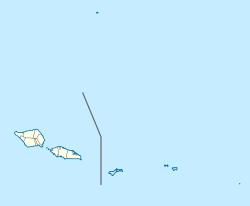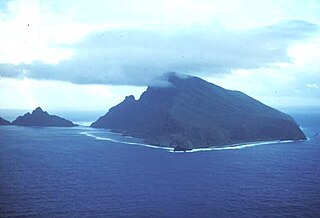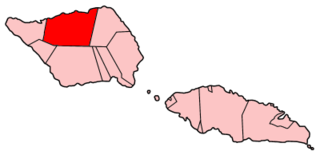| Lefagaoali'i | |
|---|---|
| Village | |
View of Lefagaoali'i from the south at Mata o le Alelo pool | |
| Coordinates: 13°28′1″S172°25′16″W / 13.46694°S 172.42111°W Coordinates: 13°28′1″S172°25′16″W / 13.46694°S 172.42111°W | |
| Country | |
| District | Gagaifomauga |
| Population (2006) | |
| • Total | 469 |
| Time zone | -11 |
Lefagaoali'i is a village on the central north coast of Savai'i island in Samoa. [1] The village is in the electoral district of Gagaifomauga. [2]

Savaiʻi is the largest and highest island in Samoa and the Samoan Islands chain. The island is the fifth largest in Polynesia, behind the two main islands of New Zealand and the Hawaiian Islands of Hawaii and Maui.

Samoa, officially the Independent State ofSamoa and, until 4 July 1997, known as Western Samoa, is a country consisting of two main islands, Savai'i and Upolu, and four smaller islands. The capital city is Apia. The Lapita people discovered and settled the Samoan Islands around 3,500 years ago. They developed a unique Samoan language and Samoan cultural identity.
The settlement is situated on a thin spit of land with the ocean on the north side and an inland lake with mangroves on the south side which flows out to the open sea through a gap at the west end of the village. The main island road circling Savai'i passes the village at the east end at the bottom of a steep hill. At the base of the cliffs at the east end of the village, and by the sea, are freshwater springs used by the people of Lefagaoali'i and neighbouring villages.
To the east of Lefagaoali'i are the villages of Samauga and Safotu. On the south and towards the west are Safune, Faletagaloa and Sasina.

Samauga is a village on the central north coast of Savai'i island in Samoa. The village is in the electoral district of Gagaifomauga.

Safotu is a village on the central north coast of Savai'i island in Samoa. Safotu is in the district Gagaifomauga. Traditionally, it attained the status of 'Pule,' customary political authority, and has been the main centre of the Gagaifomauga district.

Safune is a traditional village district on the central north coast of Savai'i island in Samoa. It lies within the electoral constituency of Gaga'ifomauga. Safune is the birthplace of Mau leader Olaf Frederick Nelson and the filming location of Moana, one of the first documentaries made in the world. The Mata o le Alelo pool associated with the Sina and the Eel Polynesian legend is also in Safune.
There are reef breaks for surfing directly in front of the village although the waves are not for the inexperienced.

Surfing is a surface water sport in which the wave rider, referred to as a surfer, rides on the forward or deep face of a moving wave, which usually carries the surfer towards the shore. Waves suitable for surfing are primarily found in the ocean, but can also be found in lakes or rivers in the form of a standing wave or tidal bore. However, surfers can also utilize artificial waves such as those from boat wakes and the waves created in artificial wave pools.















